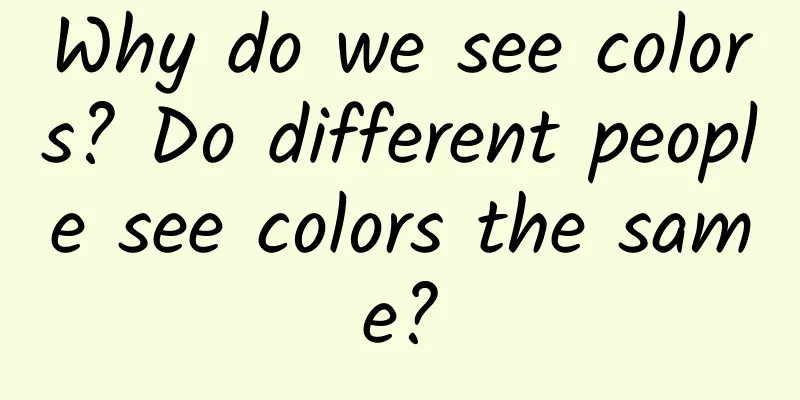Why do we see colors? Do different people see colors the same?

|
The world is so fascinating in large part because we can see in a wide variety of colors. Have you ever thought about this question: Does the same color look the same to different people? I believe many people have had this question, because many times we think something beautiful is not beautiful to others, and we think something ugly is not beautiful to others. To get the answer to this question, we must first know why people can see colors. We know that visible light has seven different colors, namely red, orange, red, green, blue, indigo and violet, and the first person to separate visible light was Newton. Ordinary sunlight looks white, but Newton used a prism to separate white light into seven different colors. This is the dispersion experiment. The reason why white light can be separated into different colors by a prism is that each color of light has a different wavelength, and the refractive index of light of different wavelengths is different. Now we know that white light is composed of seven colors of light, but in daily color matching we do not need to use seven colors of light, but only three, which are the three primary colors of red, green and blue that we are familiar with. All other colors can be matched with these three colors, and the light of these three colors overlapped is also white. Why can we use three colors of light to mix all other colors? The problem is not the color itself, but the process of how we perceive color. People can see because they have eyes, and there are two types of cells in the human eye, one is called "rod cells" and the other is called "cone cells". Rod cells are responsible for sensing light, while cone cells are responsible for sensing color. The cone cells in the human eye can be divided into three types, one of which is most sensitive to light with a wavelength of about 560 nanometers, another is most sensitive to light with a wavelength of about 530 nanometers, and the third is most sensitive to light with a wavelength of about 440 nanometers. If we look at the light wavelength comparison table, we will find that a wavelength of 560 nanometers is red light, a wavelength of 530 nanometers is green light, and a wavelength of 440 nanometers is blue light. When red light enters our eyes, the red cones are stimulated and send signals to the brain. After the brain processes the signals, we perceive red. If red and green light enter our eyes at the same time, the red and green cones are stimulated at the same time, and both send signals to the brain. At this time, the brain receives two signals and creates a feedback signal, and then we perceive yellow. It is worth noting that the yellow feedback signal is fabricated by the brain through comprehensive processing of information, so it is a subjective feeling. Since color is a subjective feeling of the brain, we have reason to believe that different people may see different colors, which is why some people like yellow, while others hate it. Another support for the view that "color is a subjective feeling" is color blindness. When a person's red cone cells have problems, he can't distinguish between red and green, so he becomes red-green color blind, but they can still see yellow. Isn't it strange? It doesn't make sense that if there is a problem with the red cones, one can still see yellow, a mixture of red and green. But if color is a purely subjective feeling, and the brain "makes up" it based on the signals it receives, then it makes perfect sense. Color is not only a subjective feeling of the brain, but the brain also adjusts this feeling based on external information. For example, if a color represents positive things for a long time, we will gradually like this color. Therefore, many Chinese people like red, while Westerners seem to prefer green. Because in China, red mostly represents positive things, such as red flags, or rising stocks, while in Western countries, red is used only when stocks fall. For more information, please follow the official account: sunmonarch |
>>: Science and technology illustration | Equip mines with a "smart brain"
Recommend
Concentrated Angelica Pills
Medicine is very common. Different medicines have...
The efficacy and function of wild goose feet [picture]
After thousands of years of sedimentation and acc...
The efficacy and function of palm crab grass
Palmaria officinalis is a traditional Chinese med...
There's only one drug left to fight this "human killer," and now it's starting to fail
Salmonella enterica serovar Typhi (S. typhi) Imag...
The efficacy and function of thorny water chestnut
Echinops is a kind of traditional Chinese medicin...
Not only are these foods not "toxic" after sprouting, they may also have higher nutritional value. Don't waste them!
This article was reviewed by Zhang Zhaomin, Maste...
Can wolfberry be taken for a long time?
In real life, many people are familiar with wolfb...
The efficacy and function of scale hook wind
Chenggoufeng is a very common Chinese medicine an...
The efficacy and function of Tuerfeng
Nowadays, our living standards are constantly imp...
The efficacy and function of bamboo heart
Bamboo heart is a kind of Chinese medicinal mater...
The efficacy and function of lotus seed heart
The traditional Chinese medicine lotus seed heart...
Cucumbers are obviously green, so why are they called cucumbers?
This article was reviewed by Sun Hai, a plant sci...
The efficacy and function of horse trip grass
Horse Chestnut is a common Chinese medicinal mate...
What are the effects of mulberry leaf powder
Everyone is familiar with mulberry leaves. In anc...
How did the "Salt Yellow Fragrant Rice" with an output of 505 kg per mu in saline-alkali land come about?
On October 27, the Institute of Genetics and Biol...









